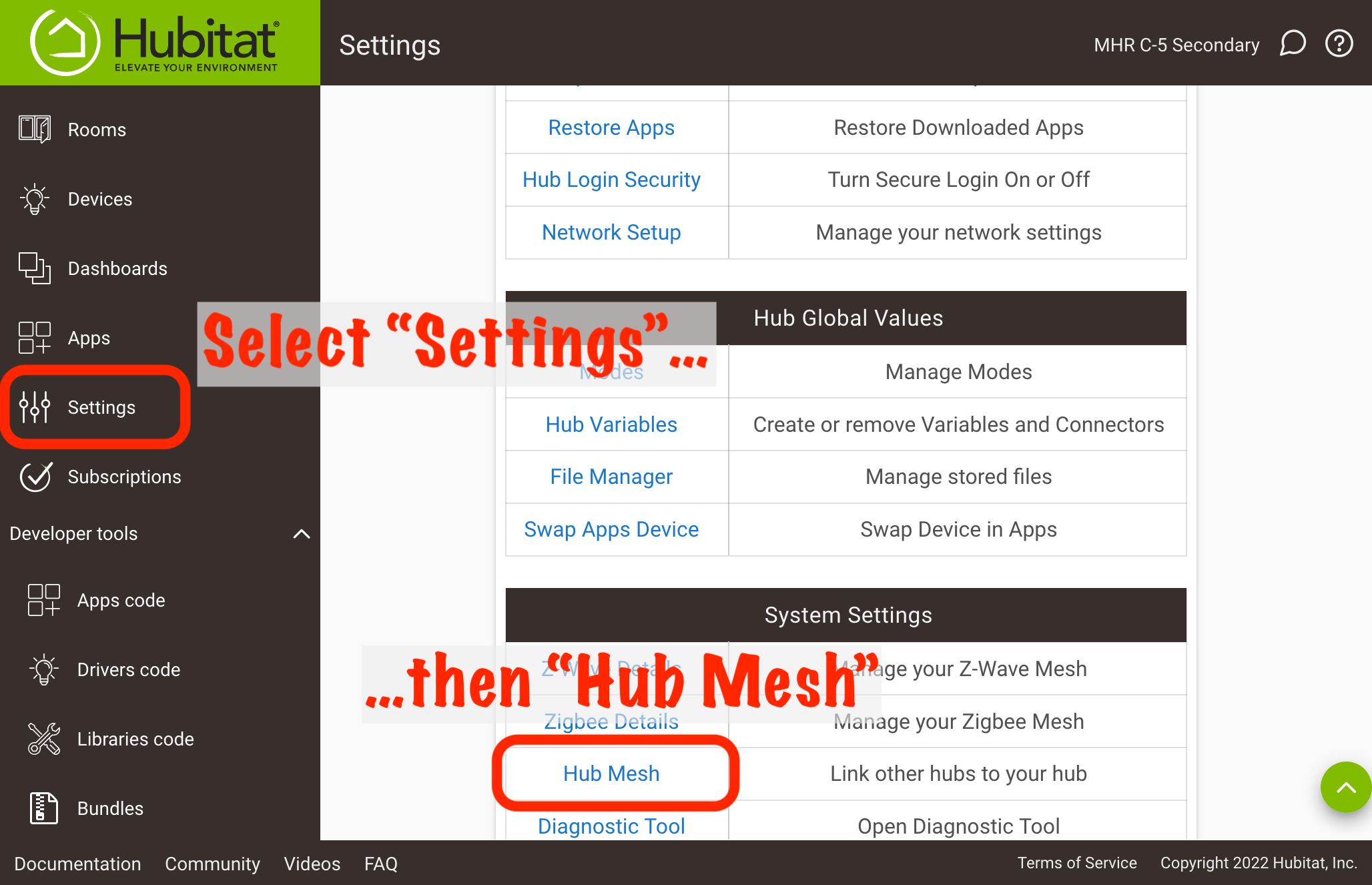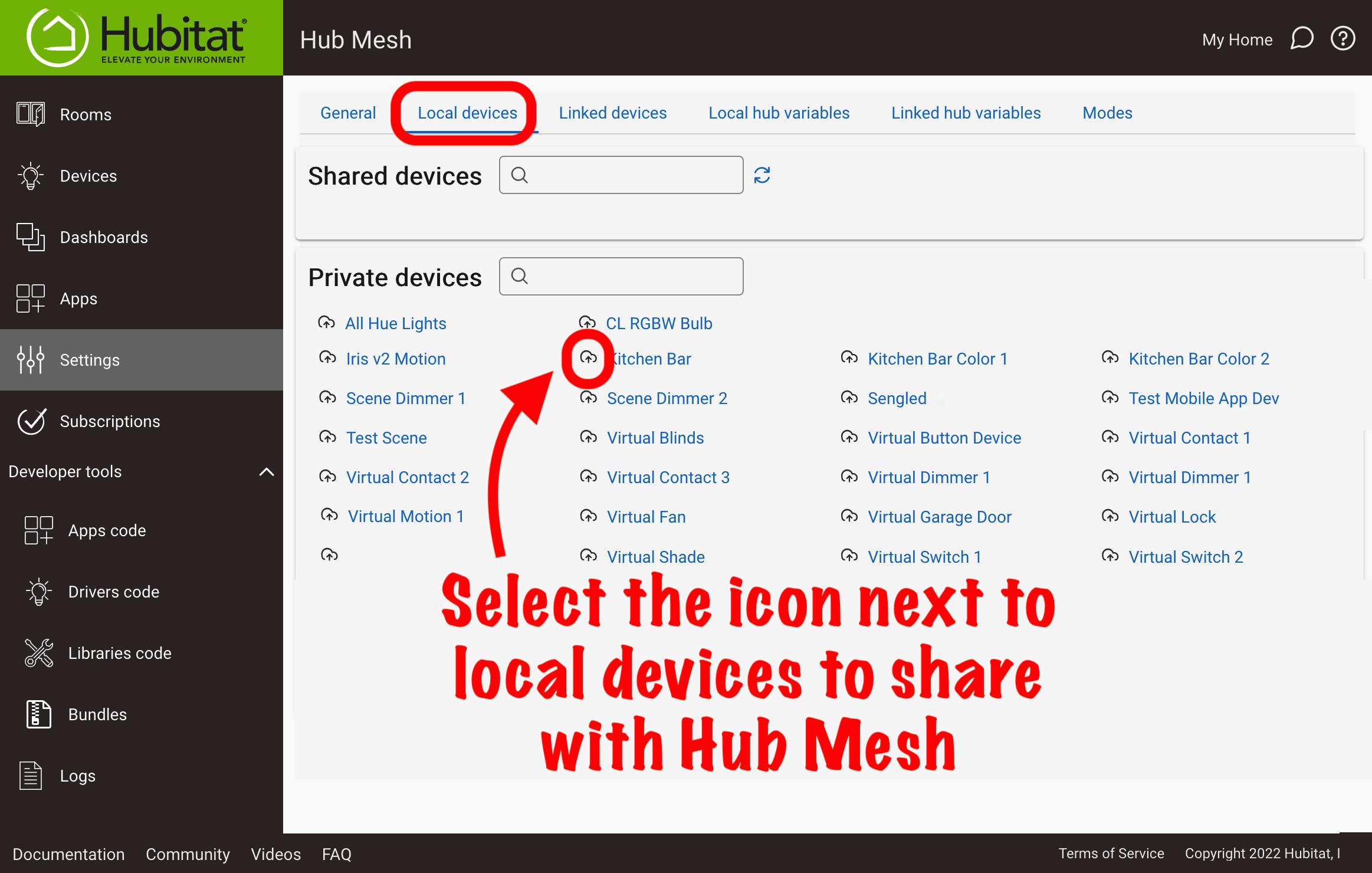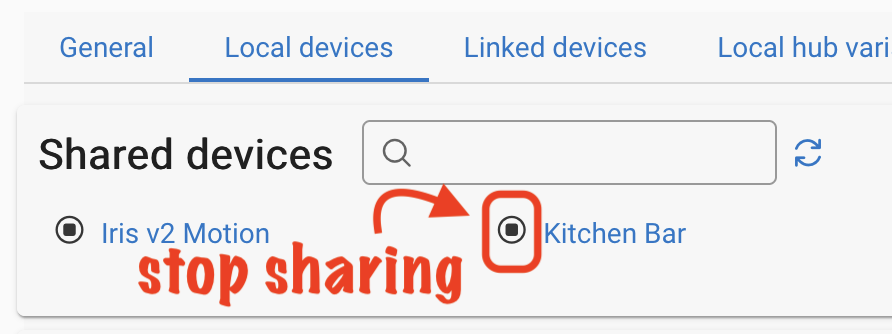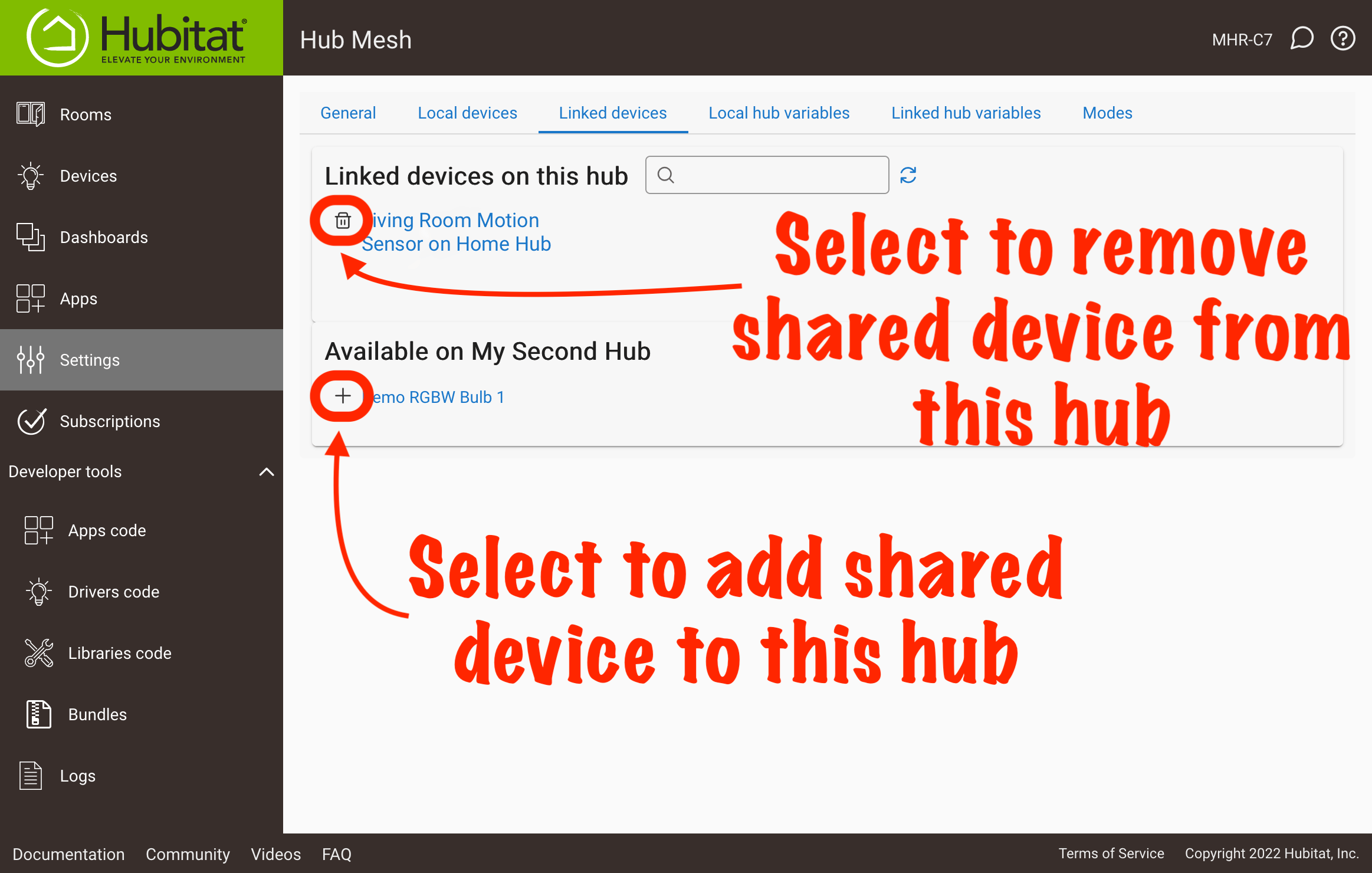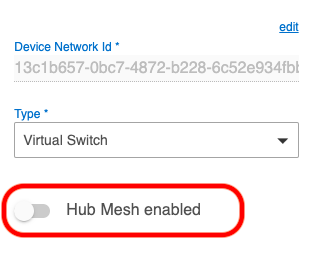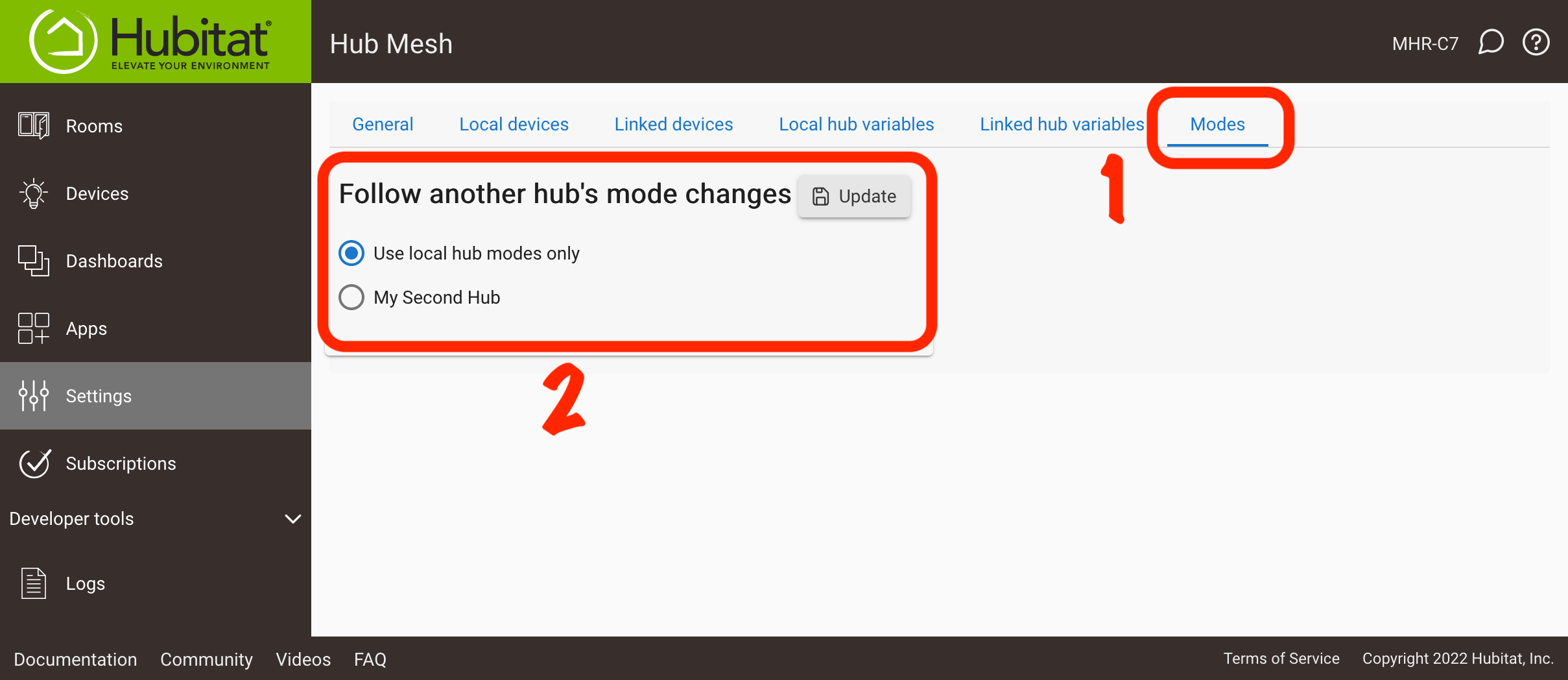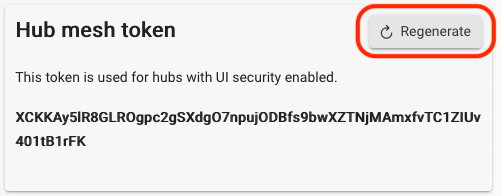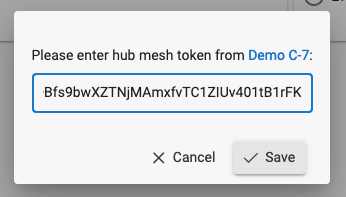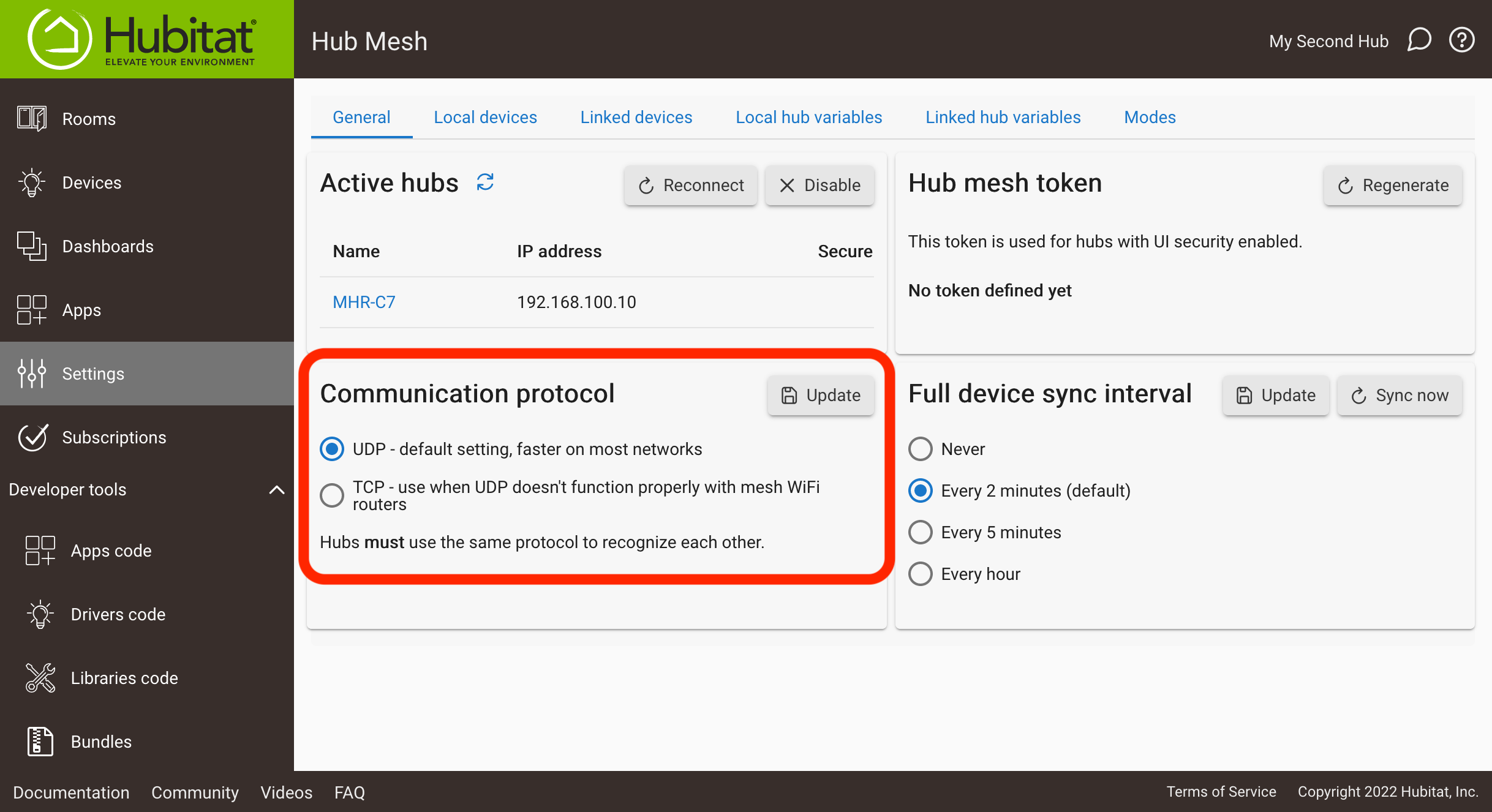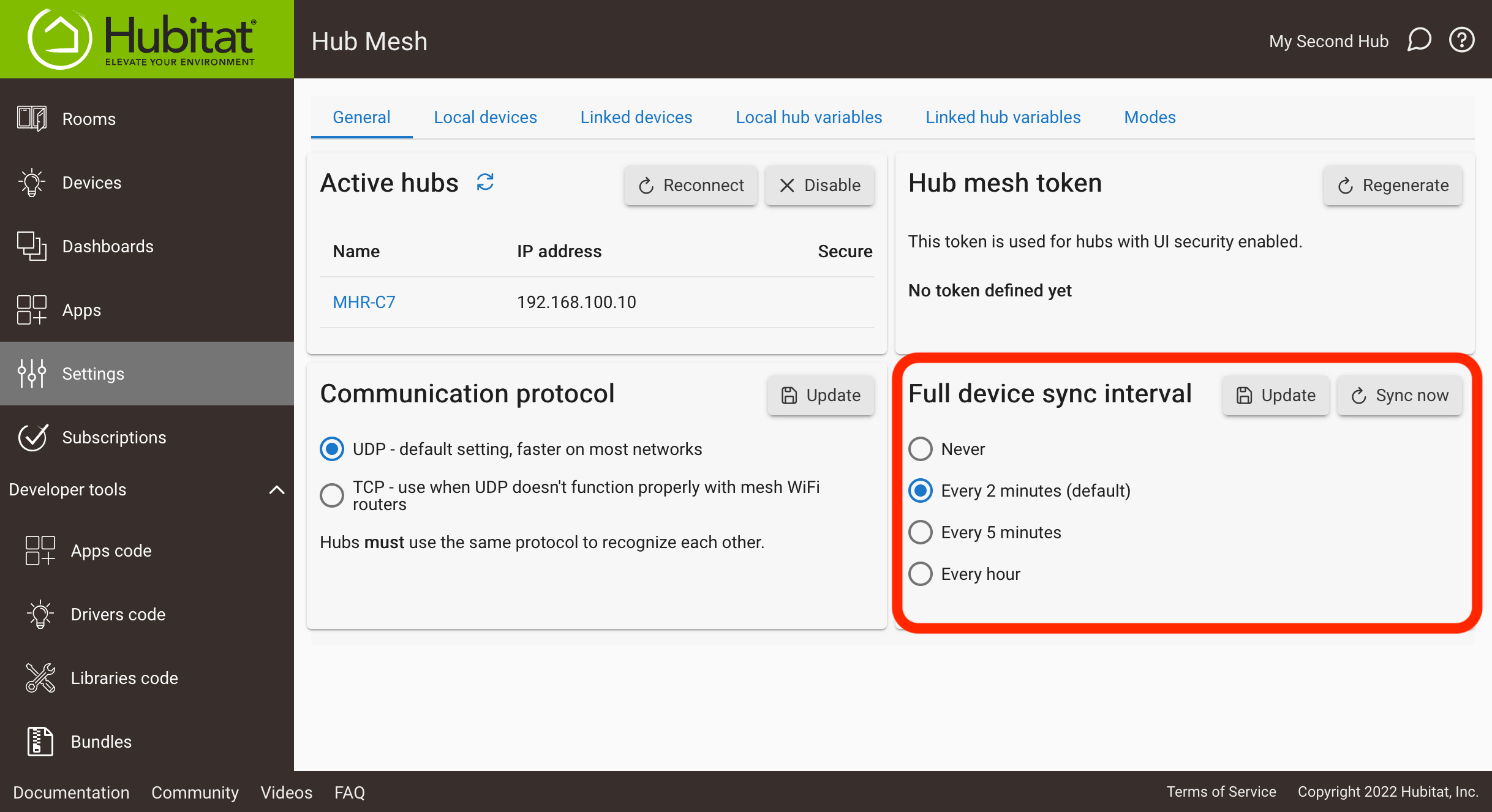Difference between revisions of "Hub Mesh"
(Tag: Visual edit) |
(Updated security info) (Tag: Visual edit) |
||
| Line 30: | Line 30: | ||
<big>When [[Hub Login Security|'''Hub Login Security''']] is enabled on the hub from where devices are shared, it is necessary to provide the linking hub with a security key. Failing to do this will result in linked devices that do not synchronize with the sharing hub.</big> | <big>When [[Hub Login Security|'''Hub Login Security''']] is enabled on the hub from where devices are shared, it is necessary to provide the linking hub with a security key. Failing to do this will result in linked devices that do not synchronize with the sharing hub.</big> | ||
| − | #<big>With Hub Login Security enabled, a lock icon will appear next to the '''Active hubs''' list. This will show a warning when the security key from the sharing hub is not available to the linking hub.</big> | + | #<big>With Hub Login Security enabled, a lock icon will appear next to the '''Active hubs''' list. This will show a warning with an exclamation mark icon when the security key from the sharing hub is not available to the linking hub.</big>[[File:No-token-provided-icon.png.png|alt=Shows Hub Mesh with no token provided error/"exclamation mark" icon when hub login enabled|none|thumb]] |
| − | #<big>Copy the security key from the sharing hub. If one has not been set or it needs to be updated, | + | #<big>Copy the security key from Hub Mesh settings on the sharing hub. If one has not been set or it needs to be updated, select '''Regenerate''':</big>[[File:Token-regenerate.png|alt=Screenshot of "Regenerate" button in "Hub mesh token" settings section|none|thumb]] |
| − | #<big>In the '''Active hubs''' list, | + | #<big>In the '''Active hubs''' list, select the exclamation mark warning icon next to the hub with login security enabled, and enter the key from the other hub from the previous step:</big>[[File:Enter Hub Mesh security key.png|none|thumb|600x600px|link=https://docs.hubitat.com/images/6/62/Enter_Hub_Mesh_security_key.png |alt=Paste the security key from the sharing hub into the text field of the hub you want to share devices with, and press the Save button below the text field.]] |
#<big>Once a valid key from the sharing hub has been entered, the warning icon will disappear and device synchronization will resume. If the warning icon does not disappear in the '''Active local hubs''' list, refresh your browser.</big>[[File:Valid Hub Mesh key entered.png|none|thumb|481x481px|link=https://docs.hubitat.com/images/3/3b/Valid_Hub_Mesh_key_entered.png |alt=If there is no warning icon to the right of the hub's IP address in the "Active local hubs" list found at the top-left of the Hub Mesh settings page, then the hub has a valid security key.]] | #<big>Once a valid key from the sharing hub has been entered, the warning icon will disappear and device synchronization will resume. If the warning icon does not disappear in the '''Active local hubs''' list, refresh your browser.</big>[[File:Valid Hub Mesh key entered.png|none|thumb|481x481px|link=https://docs.hubitat.com/images/3/3b/Valid_Hub_Mesh_key_entered.png |alt=If there is no warning icon to the right of the hub's IP address in the "Active local hubs" list found at the top-left of the Hub Mesh settings page, then the hub has a valid security key.]] | ||
| Line 52: | Line 52: | ||
#<big>'''If I use custom drivers on the "source" hub, does the custom driver also need to be installed on the remote hub?''' No.</big> | #<big>'''If I use custom drivers on the "source" hub, does the custom driver also need to be installed on the remote hub?''' No.</big> | ||
#<big>'''Does Hub Mesh extend the range of a Z-Wave or Zigbee network if I enable the feature on multiple hubs?''' No, each hub would still have its own Z-Wave and/or Zigbee mesh network(s). Hub Mesh is a way to share devices from one hub to another over your LAN. Hub Mesh has no awareness of the underlying device protocol, whether Zigbee, Z-Wave, virtual, LAN, or cloud.</big> | #<big>'''Does Hub Mesh extend the range of a Z-Wave or Zigbee network if I enable the feature on multiple hubs?''' No, each hub would still have its own Z-Wave and/or Zigbee mesh network(s). Hub Mesh is a way to share devices from one hub to another over your LAN. Hub Mesh has no awareness of the underlying device protocol, whether Zigbee, Z-Wave, virtual, LAN, or cloud.</big> | ||
| − | #<big>'''One of my Hub Mesh hubs cannot see other hub(s). What can I do?''' Check that each hub is using the same protocol for Hub Mesh (TCP or UDP; UDP is default, but TCP may be needed on some networks, like Wi-Fi mesh networks). Also verify that all hubs are running the same platform version (recommended, though not always required | + | #<big>'''One of my Hub Mesh hubs cannot see other hub(s). What can I do?''' Check that each hub is using the same protocol for Hub Mesh (TCP or UDP; UDP is default, but TCP may be needed on some networks, like Wi-Fi mesh networks). Also verify that all hubs are running the same platform version (recommended, though not ''always'' required).</big> |
Revision as of 01:27, 3 August 2022
When two or more Hubitat Elevation hubs run on the same local network, you can seamlessly share and use devices in automations among multiple hubs with Hub Mesh. Using a simple "share and link" setup, all participating Hubitat Elevation hubs are able to effortlessly control and stay in sync with local devices and (optionally) mode changes.
Contents
Configuring Hubitat Hub Mesh
- From the Hubitat Web Interface select Settings, then Hub Mesh.
- NOTE: Hub Mesh is not available on hubs running a platform version prior to 2.2.4.x. It is recommended to keep all Hub Mesh hubs on the same platform version.
- To share a device from the current hub with other hub(s), select the Local Devices tab. Select the small "up" icon next to a device to share it with Hub Mesh.
- Devices that have been shared will appear in the Shared devices list at the top of the Local Devices tab. Selecting any of the device names in the list will take you directly to the settings page of that device. Select the "stop" icon to the left of any device to stop sharing that device via Hub Mesh.
- On another hub where you would like to link to devices shared in Hub Mesh, navigate to Settings > Hub Mesh and then select the Linked Devices tab. If your shared devices do not show up in the remote devices list, refresh your browser or use the "refresh" (arrows icon) towards the top of the Linked Devices page. Select the "+" icon next to a remote device (under Available On Hub Name) to add it to this hub, or select the trash icon next to a shared device that was added (under Linked devices on this hub) to remove it from this hub.
- Links from shared Hub Mesh devices will be created in the devices list of the hub linking to them. Multiple hubs can link to devices shared through Hub Mesh.
- NOTE: Device Preferences and Information changes will update on linked device after 1 minute, but they cannot be changed from the linked device.
- You may also add a single device to Hub Mesh by simply turning on the Hub Mesh enabled option on the Device Detail page of the device you wish to share with other Hubitat Elevation hubs.
- NOTE: To actually add the shared device to other hubs, you will still need to use the Linked devices tab on the hub where you want the linked device to be added, as described above in Step 4.
- Devices which were linked to other hubs will not be deleted when they are removed or unavailable to Hub Mesh, but will instead switch to a Disabled state. If you add them to the mesh again or the hub which was sharing them returns to Active status, the linked devices will be automatically re-enabled.
- NOTE: If you no longer want a Hub Mesh Linked Device in your device list, it must be manually removed.
Sharing Hub Variables
Hub variables can be shared in a manner similar to devices. Use the Local hub variables tab to share variables from the current hub via Hub Mesh, and used the Linked hub variables tab to add devices to the current hub that have been shared from other hubs.
Follow Modes
You can set Hub Mesh to follow Mode changes of other hubs by using the Modes tab.
- IMPORTANT: If you have Mode Manager installed, you should uninstall it from hubs participating in Follow Modes. Using Mode Manager together with the Follow Modes feature could change a mode one way, and Mode Manger would change it another when trying to follow the other hub's mode. Possible conflicts, including a mismatch of defined modes on the participating hubs may result.
Using Hub Mesh with Hub Login Security
When Hub Login Security is enabled on the hub from where devices are shared, it is necessary to provide the linking hub with a security key. Failing to do this will result in linked devices that do not synchronize with the sharing hub.
- With Hub Login Security enabled, a lock icon will appear next to the Active hubs list. This will show a warning with an exclamation mark icon when the security key from the sharing hub is not available to the linking hub.
- Copy the security key from Hub Mesh settings on the sharing hub. If one has not been set or it needs to be updated, select Regenerate:
- In the Active hubs list, select the exclamation mark warning icon next to the hub with login security enabled, and enter the key from the other hub from the previous step:
- Once a valid key from the sharing hub has been entered, the warning icon will disappear and device synchronization will resume. If the warning icon does not disappear in the Active local hubs list, refresh your browser.
Adjusting Communication Protocol for Hub Mesh
- By default, Hub Mesh uses the UDP protocol for keeping devices in sync between your hubs, but UDP may not function properly with some mesh WiFi routers. If sync issues occur. you have the option to instead use the TCP protocol. The protocol should be set the same on all participating hubs.
- NOTE: Not all networks and mesh WiFi routers will have issues with UDP. Test your shared Hub Mesh devices before making adjustments.
Full remote device sync
- When more than approximately 200 devices are shared in a Hub Mesh, there may be concern over the increased amount of network traffic and load on the source hub. You may therefore disable or extend the amount of time before a Full remote device sync is performed.
- You can also completely disable synchronization by selecting Never. An example of how this might be used is when controlling a light from the destination hub, but you are only concerned about status updates on the source hub. This setting will stop all shared device synchronization from the source hub.
Hub Mesh FAQs
- If I use custom drivers on the "source" hub, does the custom driver also need to be installed on the remote hub? No.
- Does Hub Mesh extend the range of a Z-Wave or Zigbee network if I enable the feature on multiple hubs? No, each hub would still have its own Z-Wave and/or Zigbee mesh network(s). Hub Mesh is a way to share devices from one hub to another over your LAN. Hub Mesh has no awareness of the underlying device protocol, whether Zigbee, Z-Wave, virtual, LAN, or cloud.
- One of my Hub Mesh hubs cannot see other hub(s). What can I do? Check that each hub is using the same protocol for Hub Mesh (TCP or UDP; UDP is default, but TCP may be needed on some networks, like Wi-Fi mesh networks). Also verify that all hubs are running the same platform version (recommended, though not always required).

